Thrice as Nice





201 S. McPherson Church Road • McPherson Square 910-864-2965 • HinkampJewelers.com
Weekdays, 10am – 6pm and Saturdays, 10am – 5pm








201 S. McPherson Church Road • McPherson Square 910-864-2965 • HinkampJewelers.com
Weekdays, 10am – 6pm and Saturdays, 10am – 5pm



Residents traded invasive Bradford pear trees for free native replacements, like this American beautyberry, through a statewide program.


www.kidsfirstpedsraeford.com
• Well Child Visits
• Sick Child Visits
• Vaccine & Immunization Schedule
• 2025-2026 Guide to the Flu
• Autism Spectrum Disorder
• Vaccines & Immunizations
• ADHD Testing & Treatment
• Asthma Symptoms & Treatment
• Urinalysis
• Strep and Mono Screen
• Vision and Hearing Tests
Sarah Lewis, PA-C Pediatric Services We Provide Check Ups, Sick Child Visits & More in Raeford and Fayetteville
Jose Buenaseda, MD, FAAP
Leamor Buenaseda, MD, FAAP
Sreelekha Sashidhar, MD, FAAP
Christine Arnold, CPNP-PC
Melanie Pitts, DNP, NP-C
Beverly de La Rosa, CPNP-PC
Danielle Trigg, CPNP-PC
Rachelle Olson, FNPC
Ashley Monroe, PA-C
• School, Sports, & Camp Physicals
• Breastfeeding Support
2694 NC 24-87 Cameron, NC 28326 Mon. to Fri., 8 a.m. to 5 p.m. 910.500.KIDS (5437)
BY BROOKE SHOFFNER AND DR. JOHN POULOS
Obesity is one of the most serious health challenges today. Almost half of all U.S. adults live with obesity, and another third are overweight. Extra weight doesn’t just affect appearance—it can shorten lives and increase the chances of developing serious diseases such as high blood pressure, diabetes, high cholesterol, heart disease, fatty liver disease, sleep apnea, infertility, arthritis, depression and even some cancers.
The good news is that even small amounts of weight loss can:
• Lower the risk of diabetes and heart disease
• Improve sleep and energy
• Reduce joint pain and arthritis symptoms
• Improve blood pressure, blood sugar and cholesterol
• Protect the liver from damage
Because many people struggle to lose weight and keep it off, researchers are working hard to find better solutions.
Obesity can also affect the liver leading to Metabolic Dysfunction-Associated Steatotic Liver Disease (MASLD). It affects about 40% of U.S. adults, making it the most common liver disease in the Western world.
When fat builds up in the liver, it can cause inflammation and scarring sometimes resulting in cirrhosis (severe liver damage), liver failure or even cancer.
MASLD is often connected to obesity, diabetes, high cholesterol and high blood pressure—together called metabolic syndrome.
According to Brooke Shoffner, director at Coastal Research Institute (CRI), patients don’t have to wait until it’s too late to improve their liver health. Because MASLD is so common, CRI offers free screenings to measure liver health using an advanced ultrasound called a fibroscan.

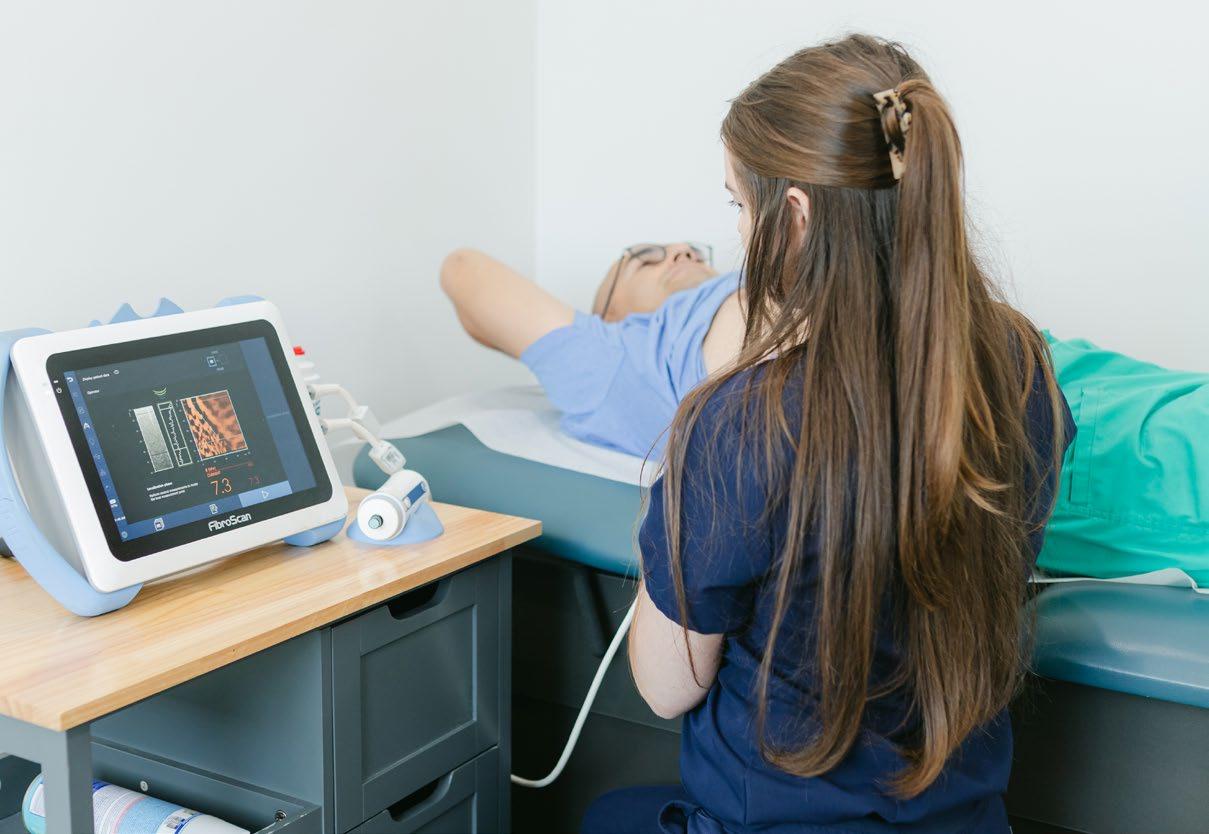
Dr. John Poulos states that CRI is not just diagnosing problems—it’s leading the way in finding solutions. Researchers at CRI have helped develop FDA-approved medicines that are now improving lives worldwide. Their work is published in top medical journals, including the New England Journal of Medicine and Lancet
Today, CRI is testing promising new treatments, including:
• Obesity medicines that can help people lose 20–30% of their body weight while improving blood sugar and liver health
• Therapies for MASLD that reduce liver damage, lower blood sugar and improve overall well-being
The team at CRI is passionate about helping people live healthier, longer lives. Research participants can gain access to cutting-edge treatments at no cost to them.
If you or someone you know struggles with weight or liver health, CRI is here to help—with free screenings, world-class research, and a supportive team dedicated to better health for everyone.
Take the first step today. Coastal Research Institute in Fayetteville, North Carolina, is ready to guide you toward a healthier future.
Have you been diagnosed with obesity, diabetes, fatty liver, Hepatitis C, ulcerative colitis or Crohns disease? Then you may qualify for free evaluation and treatment for your condition. If you or someone you know might be interested, then please contact us at Coastal Research Institute, coastalresearchnc.com, 910 500-3146, 2139 Valleygate Drive, Suite 101B , Fayetteville NC 28304.
NOVEMBER 2025

Publisher Kyle Villemain
Magazine Editor Valeria Cloës
Editorial Assistant Maydha Devarajan
Contributing Editor Katie Kosma
Director of Operation & Sales Talmadge Rogers
Administration & Operations Coordinator Caitlin Malson
Social Media Manager Grace McFadden


Sales Team Leader Dawn Denham
Photographers
James Throssel
Matthew Wonderly
Tony Wooten
Contributing Writers
Sharon Moyer
Claire Mullen
Sarah Munsch
Trey Nemec
Diane Parfitt
Tim White
Claudia Zamora
Graphic Designer
Annette Winter
Distribution
Jennifer Baker
Wayne Robinson



This year, Cumberland Community Foundation’s GivingTuesday campaign to support local nonprofits runs from Nov. 24 to Dec. 2, 2025.
During this time, CCF will amplify your gifts with matching funds provided by CCF and our generous matching donors. Since 2020, this campaign has raised over $10.6 million to give back to our community.
This year, don’t forget to support your favorite causes through the campaign and have your gift amplified!

Above, a leaf of an oak tree sits among a bundle of trees at a North Carolina Bradford Pear Bounty program event on Oct. 11 at the Cumberland County Cooperative Extension Office. Photo by James Throssel
On the cover: At a North Carolina Bradford Pear Bounty program event that visited Cumberland County on Oct. 11, participants could select an American beautyberry, a North Carolina native shrub with bright purple berries that feed wildlife, to replace their invasive Bradford pear tree. Photo by James Throssel
The North Carolina Bradford Pear Bounty program, which aims to give back to local ecosystems by trading invasive Bradford pear trees for native ones, came to Cumberland County on Oct. 11.
With hair clippers in hand, local nonprofit Cut My City co-founders create a stronger community through free haircuts, service, and a purpose-driven mission.
The public library system gives back to the community with Cumberland Cooks, a hands-on food and wellness program.

Check out Cumberland Community Foundation's Guide to Giving, a keepsake registry of local nonprofit organizations.
CCF’s GivingTuesday catalog will be open for donations from 9 a.m. Nov. 24 through 5 p.m. Dec. 2, 2025.
Have your donations amplified on





BY VALERIA CLOËS
Welcome to November! Here at CityView, we’re reflecting on the season of giving through our “Giving Issue” magazine.
For a lot of people, giving can mean financial donations or gifts, but for others, it’s giving back to the community through time and service.
CityView ’s November issue demonstrates all the ways you can give—through acts of kindness, volunteering, and community events—in the Greater Fayetteville area.
Our cover story for this edition of “The Giving Issue” highlights giving back to the environment and local ecosystem through the North Carolina Bradford Pear Bounty program. The event-based program invites participants across the state to donate their time and effort digging up their invasive Bradford pear trees, and in exchange, receive a free native replacement. An event in our county took place on Oct. 11 at the Cumberland County Cooperative Extension Office. The program is a collaboration between NC State Extension, the North Carolina Urban Forest Council, North Carolina Wildlife Federation, and North Carolina Forest Service.
Cut My City, a local nonprofit, offers free haircuts to low-income individuals in Cumberland County and beyond. Co-founders Dr. Lumumba Quow and Dr. Sundiata Morris attend events throughout the county to give these haircuts, most recently the Umoja Festival in late August, and make monthly visits to the Fayetteville Cares Day Resource Center. Beyond the haircuts, the co-founders hope to mentor and train Fayetteville’s youth in barbering.
The Cumberland County Public Library System also gives back through a new program that teaches community members cooking skills, educates them on nutrition, and promotes healthier eating habits. The program, Cumberland Cooks, uses a Charlie Cart, a mobile kitchen on wheels, to put on cooking demonstrations every month across the eight public libraries on a rotating schedule. Their first event was on Sept. 24.
This month, our columnists explore what giving and November mean to them. The first highlights the importance of local journalism and explains how you can support it through a local GivingTuesday campaign by the Cumberland Community Foundation. Another shares how

she is spending extra time leading up to Thanksgiving, acknowledging all she is grateful for and how to express that to those around her. Our bilingual columnist focuses on the Mexican holiday Day of the Dead—or Día de Muertos—that honors loved ones who have passed away. The last recommends eight books about how you can give during this season of giving.
Our November To-Do List will keep you entertained with hockey games at the Crown Coliseum, basketball and football games at local colleges and universities, and many more activities.
Were you at our Food, Wine & ART event presented by Cape Fear Valley Health on Oct. 9? We may have spotted you for this month’s Seen @ the Scene.
Get ready for Cumberland Community Foundation's GivingTuesday campaign to help support local nonprofits with its Guide to Giving publication, which is a registry of local nonprofits to help guide your GivingTuesday donations. The guide will be mailed to subscribers and will be available on newsstands across the county this month.
The foundation’s campaign this year will amplify donations with matching funds provided by the foundation and matching donors, and runs from Nov. 24 to Dec. 2.
As this November magazine shows, there are so many ways for you to give during the season. I hope the magazine inspires you as you go through the month.
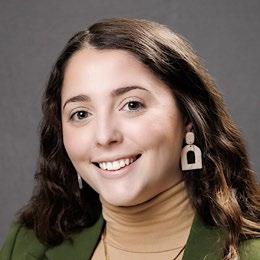
Valeria Cloës Magazine Editor
For comments, questions, feedback, or to submit story ideas, email vcloes@cityviewnc.com.

Nov. 24 - Dec. 2, 2025
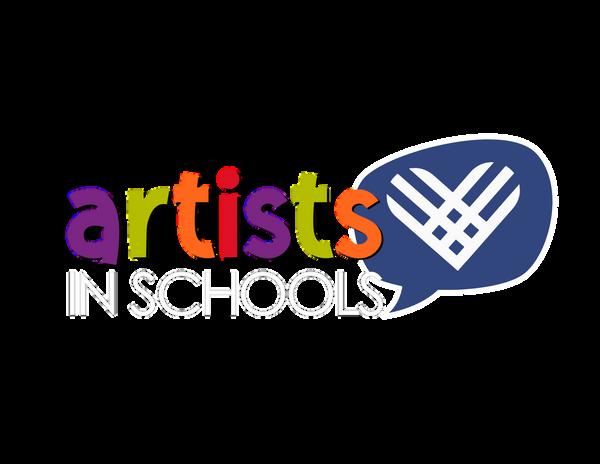

Every donation made during the GivingTuesday window is amplified, giving Cumberland County students access to lifechanging arts programs.






BY TIM WHITE
Remember those big, fat newspapers that landed on your front porch with a mighty thud? They were filled with news and advertising, with information you needed to navigate life in your community, with entertainment like comics and crosswords, with the latest sports scores and up-to-date TV listings.
For most of my life, they were essential. When I was a kid, my parents got two of them—morning and evening papers—and a third paper on Sundays. They spent hours every day devouring them; they used them to teach me to read, even before I headed off to kindergarten. As I went through high school and college, they were my primary source of information about the world around me.
journalism school scholars spend their time researching why it’s happened. The bottom line is simple: Digital giants like Google, Facebook, Amazon, and others used technology to corner the advertising market, taking all those ads, even local ones, that once funded more than three-quarters of every newspaper’s operations. The Sunday paper, once measured in pounds, shrank to something that could be thoroughly read in minutes—if you even cared about the content, which too often was about people and places other than your own community. So here we are: Newspapers are dead or dying. What do we do? Must we navigate life in our communities with no information—or worse, with gossip and hearsay?
Really, the new bottom line is this: We can be as good as you help us be. We have a lot of plans, formed in discussions that happen almost every day... The list of wants and needs is endless, but it’s only wishful thinking without your help.
And then they became my livelihood, first as a reporter and photographer, and then, for decades, as an editor. I didn’t know it at the time, but I was living in newspapers’ golden age, when pre-tax profits often topped 40%, but publishers still were making enough money to invest heavily in staff and technology. Then it all crashed.
You saw it here in Fayetteville, in the first two decades of this century, as our prized local daily grew thinner and less newsy, and a newsroom staff that once approached triple digits slimmed to a skeletal force. You weren’t alone— almost every community in the United States has been on the same forced information diet. Some towns are already “news deserts,” with no news coverage at all. Most still have a vestige of news, but it’s easy to see the desert advancing. Books have been written about the collapse of news;
No, our civic future isn’t that bleak. News isn’t dead, and neither is good journalism. Students are still going to journalism school, and they’re doing excellent reporting work. If you’re reading CityView, you already know that. You know that the glossy magazine expanded a few years ago to include a daily news report. You know that the staff has slowly but steadily grown, and that includes some of Fayetteville’s veteran reporters, bylines you’ve followed for years.
But you may not know this: Those reporters are paid, in part, through the generosity of local donors and institutional grants. While the CityView operation is somewhat conventional, still able to turn a profit from advertising sales and events, the cash flow is a pale shadow of what once fueled a great, family-owned daily here. Like many other news organizations, CityView
depends on its readers to accomplish its mission. That’s why we created the News Foundation of Greater Fayetteville, the nonprofit that funds several of CityView ’s reporters. We hope to continue growing our newsroom and expanding our news coverage, but we can’t do it unless you help us.
Really, the new bottom line is this: We can be as good as you help us be. We have a lot of plans, formed in discussions that happen almost every day. We know we need to add reporters so we can give you a more thorough news report every morning. We know we need at least one reporter on Fort Bragg—the biggest (by population) military base in the country and maybe the world. We know we need a business and economics reporter, an arts and entertainment reporter, and more. The list of wants and needs is endless, but it’s only wishful thinking without your help.
As we approach the annual “GivingTuesday” event, which begins Nov. 24, I’m hoping you’ll join me in supporting CityView ’s reporting. The fundraiser for Cumberland County community nonprofits runs through Dec. 2. The Cumberland Community Foundation, which runs the event here, has $500,000 in matching funds available thanks to local donors. We’ll have a donation link on the CityView website, and one on the News Foundation’s site as well— faynews.org/givingtuesday. Those gifts are all tax-deductible. If you can, please help us grow our newsroom team in Fayetteville. Nobody should ever have to live in a news desert.
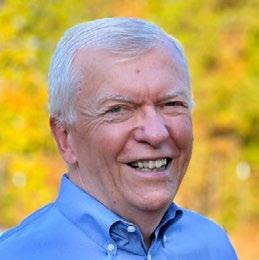
Tim White is vice chairperson of the News Foundation of Greater Fayetteville. For two decades, he was the editorial page editor of The Fayetteville Observer.


Smart food disposal can help protect our environment, our sources of drinking water, and your own property. Dumping grease, fats, and oil down the drain is not only illegal, but it can also cause sewage back-ups and flooding. Sewage back-ups can damage personal and public property. Learn more at FayPWC.com/Cease-The-Grease
BY CLAIRE MULLEN
While it’s always good practice to move through daily life with a general spirit of thankfulness, we are all hopefully spending a little extra time leading up to Thanksgiving later this month reflecting more deeply on the things for which we are thankful, and the ways in which we can express that thankfulness.
It’s easy to say “thank you,” and we all probably habitually utter the word “thanks” dozens of times each day, for things as mundane as the grocery store cashier handing you your receipt, the person in front of you holding the door, or your spouse passing the salt shaker across the dinner table. In these cases, “thanks,” while very important, is more of a polite pleasantry than a profound expression of true gratitude.
On a recent evening at our local ballpark, I observed a very sweet exchange that really stuck with me. It served as a reminder for me of the difference between an in-passing “thanks” and an impactful “thank you.”
My son’s 10U baseball team had just finished their game and found a corner of the park where they could congregate and conduct their post-game huddle. As we typically do, the players’ parents and siblings gathered loosely around the team while we waited for Coach to finish discussing highlights and present the game ball. I was interrupted from stuffing my lawn chair into its bag (and apparently chomping extra loudly on a wad of Bubblicious) by a gentle tap on my elbow. The adorable little sister of one of my son’s teammates asked, “Miss Claire, do you have any more gum?”
I shuffled through my purse and came up empty handed.
“I’m sorry, sweetie. That must have been my last piece, ” I said. She replied, in her
signature spunky way, “That’s okay! Thanks anyway!”
A nearby dad, having overheard our conversation, reached into his pocket, pulled out a pack of Extra gum, and extended it to our 4th-grade friend so that she could help herself to a piece.
“Thank you!” she exclaimed, as she unwrapped the foil wrapper and popped the stick into her mouth. And then, what she said next to that dad was so endearing to me: “I am very grateful.”
A simple “thanks” would, of course, have sufficed, but this sweet little girl went even further with a sincere sentiment of gratitude that you just don’t hear every day, as if that dad had just handed her a $100 bill rather than a stick of peppermint chewing gum.
I have thought a lot about her comment since that evening at the ballpark. I am lucky to have many things in my life for which I am very grateful. I feel a lot of thankfulness on a daily basis, but do I remember to express my gratitude often enough?
There are SO many people deserving of an “I am very grateful” from me.

My children’s teachers, who show up for them daily with love and patience. Their coaches, who volunteer their time and talents. Their grandparents, who fill in the gaps and help and support our family so tremendously. My husband, who works tirelessly at his job, and still embraces his roles as husband and father with great enthusiasm and care. My three siblings, who are each wonderful human beings and contribute amazing things to our strong family unit. My friends, who are oftentimes my best sounding boards, listening ears and sources of a lot of
humor that balances the seriousness of adulthood and parenting.
I’m pretty certain all these people already know how thankful I am for them, but I also think it’s important that I remember to remind them often.
And so, as we enter into this season of gratitude, I’m going to try my best to channel the energy of my little ballpark buddy and go out of my way to express my appreciation as much as I can.
Maybe to the Harris Teeter












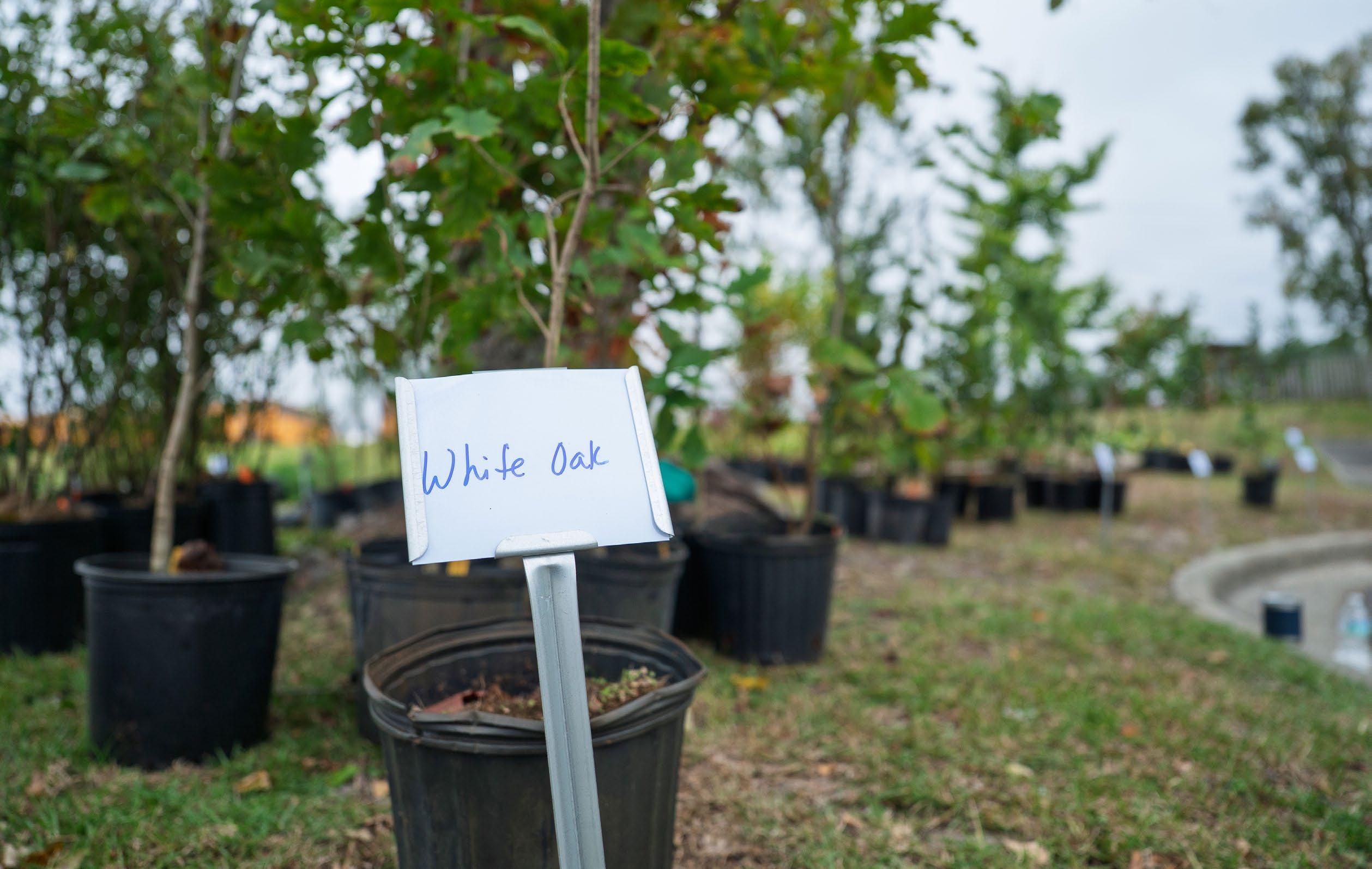
The white oak, a North Carolina native valued for its shade and wildlife support, was a popular choice at the North Carolina Bradford Pear Tree Bounty program event on Oct. 11, where participants showed proof of removal of their Bradford pear tree in exchange for a native replacement.
The North Carolina Bradford Pear Bounty program, which aims to give back to local ecosystems by trading invasive Bradford pear trees for native ones, came to Cumberland County on Oct. 11.
BY SHARON MOYER | PHOTOGRAPHY BY JAMES THROSSEL
WWhen Cumberland County joined the North Carolina Bradford Pear Bounty program this fall, residents gave back to their local ecosystem while receiving something beautiful in return. The Oct. 11 event at the Cumberland County Cooperative Extension Office drew such enthusiastic participation that all 200 available native trees were claimed, with some residents eligible to receive up to five trees each.
The program represents a unique form of community giving: Residents donate their time and effort to remove invasive Bradford pear trees, and in return, receive free native trees.
Bradford pears arrived in America in the early 1900s with good intentions to help develop disease resistance in fruit-producing pear trees. The Bradford cultivar (or a variety of plant cultivated by humans) emerged when researchers noticed one particularly attractive specimen with a beautiful crown and no thorns.
“It was believed that these trees would not be able to spread,” explained Allen West, Cumberland County’s Cooperative Extension agent. “However, different cultivars can cross, allowing them to escape into our natural forests.”


Recipients line up to receive their replacement trees, after showing before-and-after photos to prove the removal of their Bradford pear trees.
As Sean Garcia, horticulture and natural resources teacher at Gray’s Creek High School, notes, “Landscapers and architects like using them because they’re cheap and affordable, and they grow up pretty fast.”
What seemed like a generous gift to homeowners has become an ecological burden. Birds spread seeds throughout the landscape, creating wild populations that compete with native species.
Kelly Oten, North Carolina State University extension specialist and coordinator of the bounty program, emphasizes an important point.
“Just because their tree in the front yard isn’t popping babies up all over their front yard doesn’t mean their tree is not invasive,” Oten said. “The birds will eat the berries and then fly across the street, and suddenly, it becomes your neighbor’s problem.”
Bradford pears create problems on multiple fronts. Ecologically, they leaf out earlier in spring than native species, shading out the plants that local wildlife depends on for food and shelter, according to a NC State Extension Publication. Research shows that caterpillars, a critical food source for birds, prefer native trees over Bradford pears, creating food scarcity in areas dominated by the invasive species.
Practically, these fast-growing trees are structurally weak. Rapid growth creates weak joints that break during
storms and can damage property. Wild varieties can have thorns up to four inches long that can puncture equipment and injure livestock.
Even aesthetically, the trees present challenges, emitting what many describe as a rotting fish smell during their blooming period.
The Bradford Pear Bounty program launched in North Carolina in 2022 as a collaboration of NC State Extension, the North Carolina Urban Forest Council, North Carolina Wildlife Federation and North Carolina Forest Service. Since then, the program has held 16 events across the state, helping residents replace an estimated 3,300 invasive trees with native alternatives.
“Our first event in 2022 was quite large because there was so much excitement around it,” Oten recalled. “We sold out the event in less than 24 hours.”
The program’s popularity reflects a community’s willingness to invest time and effort for long-term environmental benefits.
Residents must make a modest effort to participate in the bounty program. They register online, remove their Bradford pears, and bring before-and-after photos to the event. In return, they receive various native trees and shrubs, with Master Gardener volunteers donating their


expertise to help match the right plant to each person’s specific site conditions.
“We try to pick native plants that do well in our area, and we like to have a variety,” West explains. “Some people don’t want a big shade tree in their yard, so we have native shrubs such as beautyberry and sweet shrub.”
Garcia, one of this year’s participants, had been waiting for the program to come to Cumberland County.
“I have about three Bradford pears that came with my house,” he explained. “I’ve been waiting for this opportunity to replace them with native trees I can use to teach my students.”
Each participant also receives a tree care manual from the North Carolina Urban Forest Council with detailed planting and care instructions, plus ongoing guidance from Master Gardener volunteers. The program typically offers 13 different native species, including both trees and shrubs, with selections like river birch and other locally appropriate alternatives.
For those concerned about losing the spring beauty Bradford pears provide, North Carolina offers numerous native alternatives with comparable or superior aesthetics. Flowering dogwood provides similar white spring blooms, while serviceberry offers flowers and edible berries that benefit wildlife. Black cherry creates
dramatic displays of white flower clusters, and eastern redbud adds pink spring color.
“Native trees benefit our ecosystems, allowing other native species to flourish,” West noted. These trees support local wildlife, resist pests and diseases, and integrate naturally into our local ecosystems.
While Cumberland County’s 2025 event distributed 200 trees and shrubs, the program’s impact extends far beyond those plantings. The initiative catalyzes broader community education about responsible environmental stewardship.
“We’re hoping to get a conversation going about people knowing that there are other invasive plants and to be on the lookout for them,” West explained.
Garcia uses his participation to enhance his teaching and create an additional multiplication effect. He photographs his new trees at various growth stages for student identification practice and uses cuttings for classroom activities.
“It makes me happy that at least they’re aware of the trees out there,” he said about his students’ growing identification skills.
This educational impact influences students, creating a new generation more aware of native species and environmental stewardship.
Oten stresses that the program’s lessons extend beyond formal participation.
“Just because they didn’t participate in this program doesn’t mean they shouldn’t remove their Bradford pears,” Oten said.
She encourages people to research any tree before planting it, noting that many invasive species are sold locally.
For readers throughout North Carolina, extension agents in every county can provide localized advice about appropriate native alternatives. County extension agents help determine whether someone wants spring flowers or fall color, large shade trees or smaller specimens, and what will work best for their specific site conditions.
While Bradford pears may have seemed like a good choice decades ago, we now know how to make better decisions. By choosing native alternatives, property owners can maintain beautiful landscapes while giving back to the wildlife and ecosystems that make North Carolina special.
“By choosing native alternatives and supporting removal programs,” Oten said, “we can all do our part to protect our land, wildlife, and forests.”
The program demonstrates how individual acts of environmental stewardship can create lasting positive change, a perfect example of how giving back to nature ultimately gives back to our communities.
Sharon Moyer, a native of Muskegon, Michigan, moved to Fayetteville in 1987 and has lived here since. Sharon works as the director of philanthropy and partnerships for the News Foundation of Greater Fayetteville.









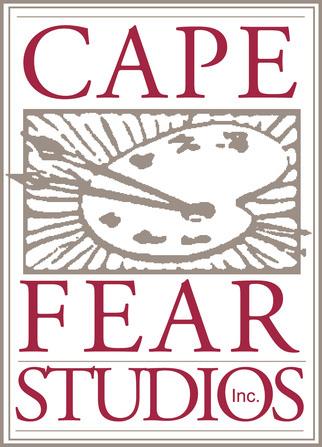
With hair clippers in hand, local nonprofit Cut My City co-founders create a stronger community through free haircuts, service, and a purpose-driven mission.
BY TREY NEMEC | PHOTOGRAPHY BY JAMES THROSSEL
TTThere is little else in the world that feels better than stepping out of the barbershop with a fresh haircut. What seems like a simple and routine act of self-grooming can completely change someone’s outlook, uplifting their confidence, putting a little extra pep in their step, and giving them the courage to face an overwhelming day.
Cut My City, a local nonprofit organization, takes this concept to a whole new level. With a mobile barbershop bus, years of experience cutting hair, and an unwavering commitment to serve the community, the organization offers free haircuts to residents of Fayetteville—and beyond—who might need a helping hand.
Built on example
Cut My City, which first received its 501(c)(3) designation in March 2023, was born out of a years-long friendship. Dr. Lumumba Quow and Dr. Sundiata Morris—who both hold Doctorates in Barbery from the National Beauty Culturists’ League’s Institute of Cosmetology—first met in Virginia and they quickly connected about family, artistry, and community.
Quow grew up in Trinidad and Tobago, a dual-island nation and the southernmost islands in the Caribbean. He told CityView that his mother was the inspiration behind his passion for community service. He watched his mom—a single parent—serve her community through cooking food and selling it at a much lower cost than others in the area to ensure her community got what it needed.
“She created events, community events, for people to have a good day,” Quow said. “I always wanted to mimic that as a kid.”
Morris, a licensed barber of 26 years and a Norfolk, Virginia, native, said he was born an artist. He fell in love with the craft after an ill-fated, self-induced haircut at age 10, which was inspired by seeing an older teenage neighbor cutting hair.
“I went home and butchered myself to death,” Morris said with a laugh. Morris recalls his mother—who he said couldn’t necessarily afford regular haircuts back then— boosting his confidence about his home haircut.
“If it was something that I liked,” Morris recalls his mom saying, “Then it would be okay, no matter what nobody else said about the haircut.” He fell in love with the craft and kept honing his skills.
When the two friends both independently relocated to the Fayetteville area—armed with a passion for community service—they saw an opportunity to create positive change for their new community. In 2007, the pair opened Barber Kings, a popular barbershop located on Hope Mills Road.
At their shop, Quow and Morris quickly made a major impact on the community around them.
Sophia Ford, a Fayetteville native, recalls Quow and Morris’s compassion and patience with her two eldest children, after having some less-than-amazing experiences at other barbershops.
“My children, they’re boys,” Ford chuckled. “They’re not bad boys, they’re very respectful, but they’re little boys. At one barbershop, there is no denying that the little kids were still expected to be quiet the whole time, and just sit and be still. We’re talking about 5- and 6-year-olds.”
What seems like a simple and routine act of self-grooming can completely change someone’s outlook, uplifting their confidence, putting a little extra pep in their step, and giving them the courage to face an overwhelming day.

Dr. Lumumba Quow, co-founder of Fayetteville barbershop Barber Kings and local nonprofit Cut My City, works on Harold Hunt’s haircut transformation on Sept. 24 at the Fayetteville Cares Day Resource Center.
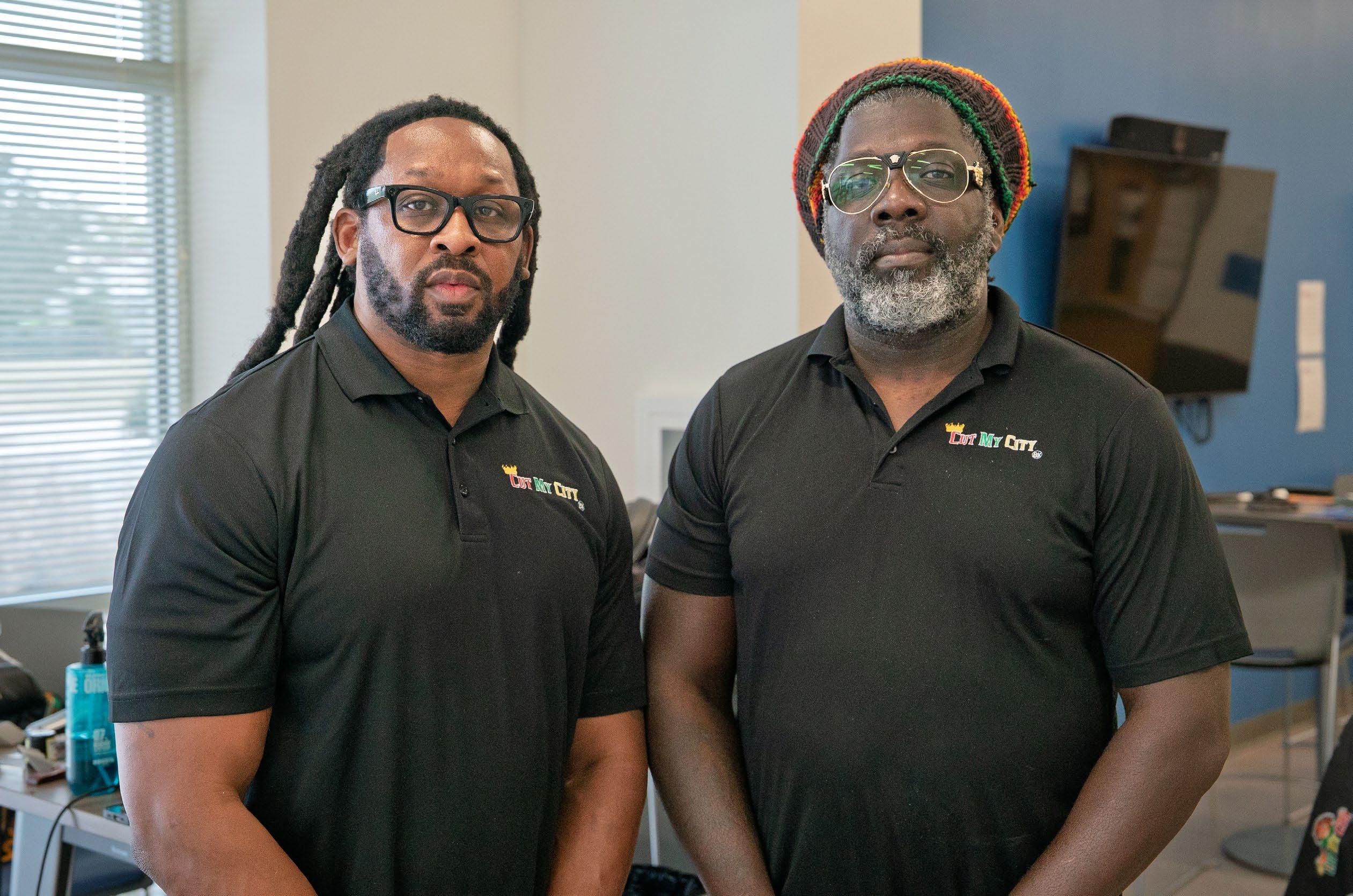
The joy that I get when I’m on that bus, to see those kids are so happy. They recognize the bus, and they can feel comfortable and not feel afraid.
— Sundiata Morris
Ford said that when she found Barber Kings, she still felt some lingering nerves, encouraging her kids to sit still and quiet for their haircut. Quow had other ideas.
“He stopped me,” Ford laughed as she explained how Quow jokingly scolded her and reminded her that children are not—by nature—still and quiet. “It felt like relief. It felt like someone who really understood.”
Quow and Morris continued to build their shop, serving the community with that same compassion and understanding. With their drive to help people—and with cordless clippers in hand—the pair took their skills and mission across the world beginning in the late 2000s. They visited places like Trinidad and Tobago, Saint Thomas, Saint Lucia, and England.
Morris described visiting orphanages where, even in the midst of tragic situations, they were able to give children free haircuts.
“The haircut, it changed everything,” Morris said, hoping that the children felt even a small portion of their prayers were answered.
On a trip to Ghana, Quow said they felt “a divine spiritual calling,” putting them in a position to concentrate on their purpose. On the trip, they felt that they were able to spread their message, providing supplies and opportunities for these outlook-changing free haircuts to spread. They brought clippers and inspiration to the people, empowering them to continue serving others.

One of the things we want to provide at Cut My City is not just to bring on people who are already professional. We want to train people.
– Sundiata Morris
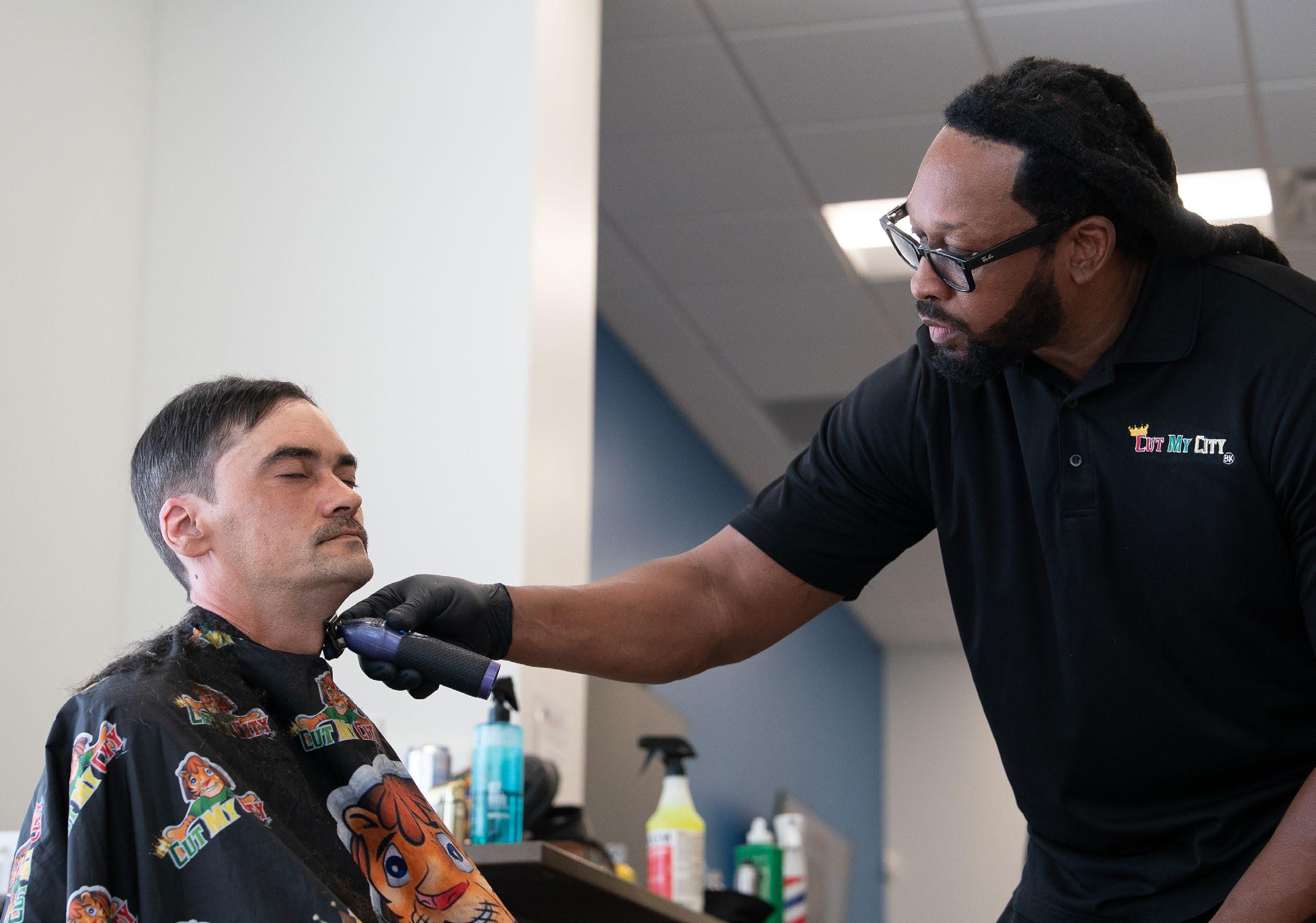
After their purpose-driven trip to Africa, Quow and Morris started driving down a new avenue on their journey. They created a mobile barbershop—a rebuilt school bus they call “The Ark”—completing the initially self-funded two-year project with the help of local sponsors, and through grant opportunities from Cumberland County and Cape Fear Valley Health. When “The Ark” was complete, Quow and Morris quickly began visiting local communities and parking at community resource events to provide free haircuts to those in need.
With clippers buzzing, Cut My City visits as many community events as they can manage. Recently, the organization attended the 33rd annual Umoja Festival— which was held at Seabrook Park in late August. Morris and Quow also visit the Fayetteville Cares Day Resource Center once a month, usually during the last week of the month, to cut people’s hair for free, Morris said. Quow said they participate in an event for homeless people every month, on top of their yearly events, to ensure that people can get the services they need.
On top of providing free haircuts and supporting local
community resource events, Cut My City plans to expand the scope of the organization’s mission. Beyond just giving free haircuts to people in need, they hope to begin mentoring Fayetteville youth.
“One of the things we want to provide at Cut My City is not just to bring on people who are already professional,” Morris told CityView. “We want to train people.”
In North Carolina, there is no minimum age requirement to enroll in barber school or get licensed as a barber—barring any labor laws that might interfere with a young person working— according to the N.C. Board of Barber and Electrolysis Examiners.
Morris explained that Cut My City aims to provide young people with the training they need to become professionals. Morris sees this training program as a way to keep teenagers busy and teach them the importance of serving those around them.
Ford told CityView that her eldest boys—twins, now age 11—will be volunteering with Cut My City during some upcoming opportunities. She said that the twins are very interested in community service, constantly trying to help others.
“To give children an opportunity like that,” Ford said. “I think that’s absolutely great.”
Between Quow, Morris, and Ford, a common thread binds together the importance of community service: unity. Quow and Morris opened Barber Kings—and later, Cut My City—with the intention of creating a space where everyone feels welcome and appreciated, regardless of any differences. They focus on helping each other, serving others, and creating as much equity and understanding in the community as they can.
So, what changes in a person when they step out of the chair with a clean haircut?
“I think it becomes very uplifting,” Morris said, describing how a haircut can be a spiritual experience. “It just seems to change the energy in the person.” He explained that what could be the worst day for someone seems to turn around when they look in the mirror after their haircut.
“The joy that I get when I’m on that bus, to see those kids are so happy,” Quow said through teary eyes. “They recognize the bus, and they can feel comfortable and not feel afraid.”
He recalled watching his family struggle when he was a child, leading him to look for solutions to the pain he saw.
“When I’m able to help somebody, I feel like it’s the best joy in the world.”
To learn more about Cut My City, visit the nonprofit's website: cutmycity.org.
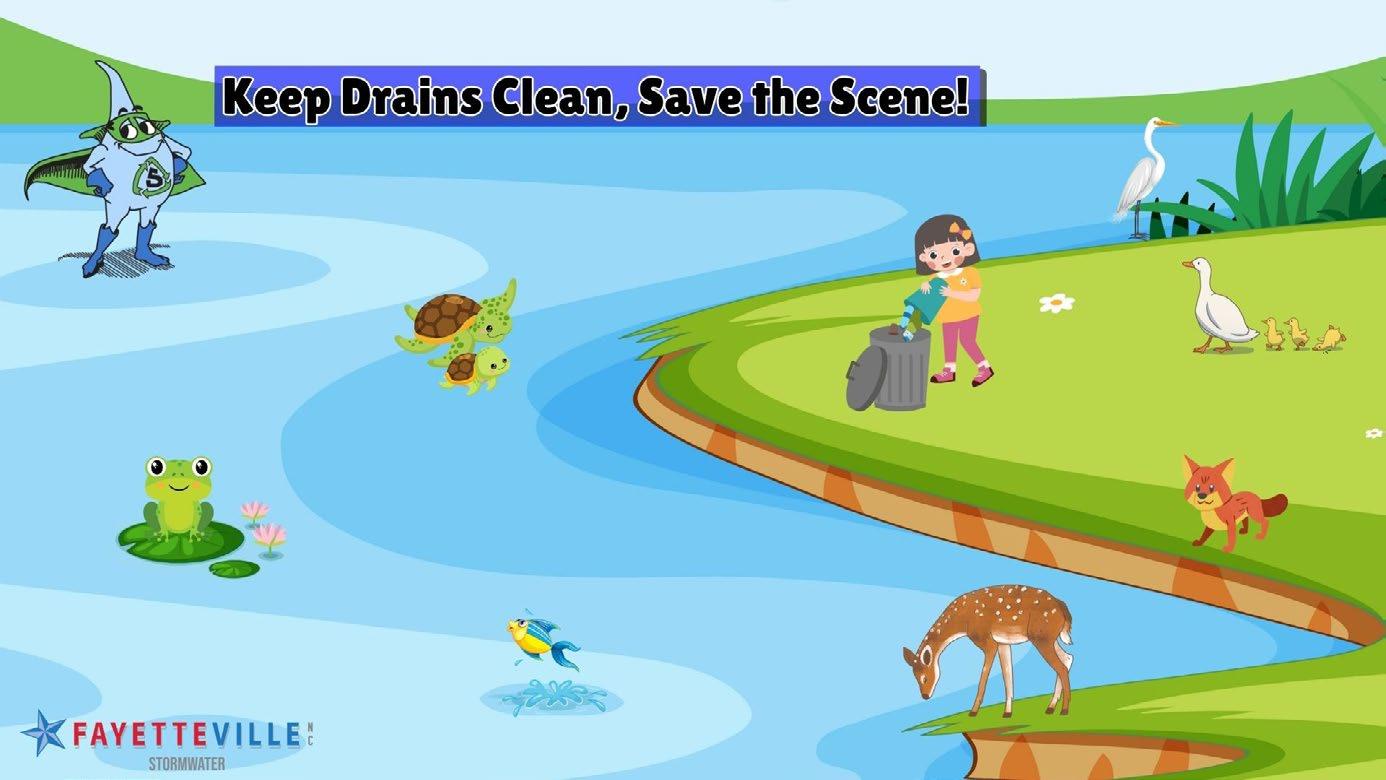




The public library system gives back to the community with Cumberland Cooks, a hands-on food and wellness program
BY SARAH MUNSCH | PHOTOGRAPHY


WWhen most people think of the library, they picture rows of books, quiet study spaces and maybe a story time or two. Now, with its newest program, the Cumberland County Public Library is reshaping what a library can be.
This fall, the Cumberland County Public Library introduced Cumberland Cooks, a free event powered by nonprofit and national food education program The Charlie Cart Project and funded by a $40,500 grant from the Institute of Museum and Library Services. Cumberland Cooks is structured to help the community learn practical cooking skills and promote healthier living through hands-on cooking classes, live demonstrations, and tastings.
Cumberland Cooks is a new culinary and wellness program that helps attendees improve their diet by educating participants on cooking skills and nutrition. It is also designed to address food insecurity—which is “the availability of nutritionally adequate and safe
foods or the ability to acquire acceptable foods in socially acceptable ways is limited or uncertain,” according to the Journal of Nutrition—in the community by increasing access to affordable and healthy food, by teaching participants to shop smart, and by providing resources on local food banks. It is a program that provides opportunities for social connection by bringing the community together in a supportive environment.
Food insecurity is an ongoing and urgent crisis in America. According to Feeding America, in Cumberland County, nearly 18% of the population in 2023 struggled with food insecurity, exceeding the national average of approximately 14%.
There are several factors that contribute to food insecurity, including, but not limited to, lack of resources, lack of knowledge, and lack of affordable, balanced meals, according to the Office of Disease Prevention and Health Promotion. When people have limited or inconsistent access to nutritious food, it can lead to adverse outcomes such as malnutrition, life-long chronic medical conditions,
These mobile teaching kitchens are more than just carts, they’re a way to connect people through food, health, and learning.
– Heather Hall, director of the Cumberland County Public Library
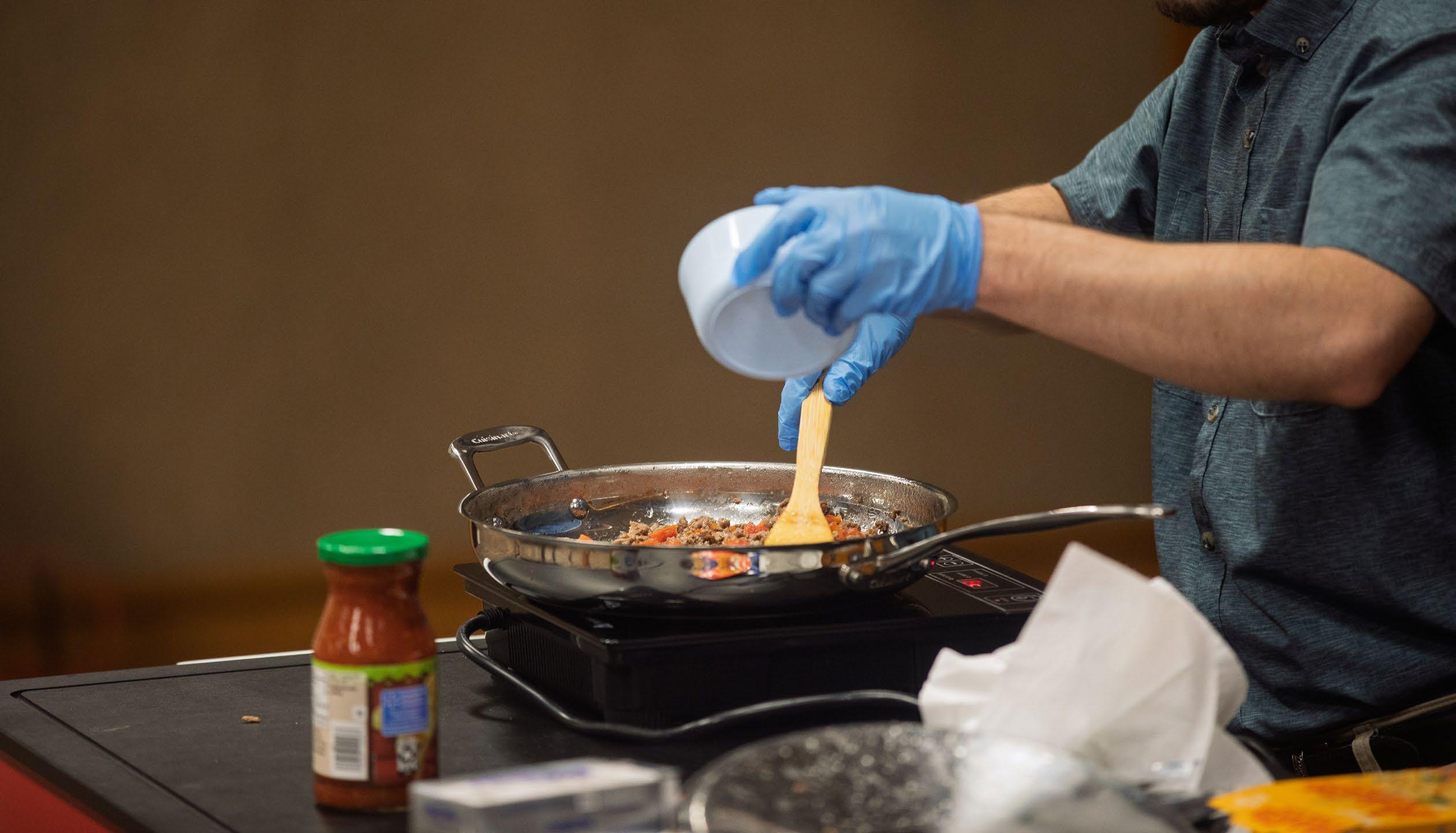
There
poor mental health, behavioral issues in children and more, according to a collection of studies in the National Library of Medicine.
Amanda Dekker, the Headquarters Library branch manager, said the library has many resources to help families put food on the table, including cookbooks, information on local food banks, sales flyers from local stores, and a service that loans out kitchen utensils.
“I think everybody’s feeling the rising costs of food and trying to make the dime go farther,” Dekker said, “and we have so many materials here that people may not even know exist. [Cumberland Cooks] is just a way to branch out, not just for cooking but how else can we help them.”
The Cumberland Cooks demonstrations will make use of a Charlie Cart, a compact kitchen on wheels. The Charlie Cart is fully equipped with everything needed to teach others to cook. It weighs around 600 lbs. and has a built-in convection oven, induction cooktop, rinse station, and is stocked with over 100 kitchen tools.
Heather Hall, the director of the Cumberland County Public Library expressed just how much the Charlie Carts helped with bringing Cumberland Cooks to life, allowing the flexibility to create the hands-on program.
“These mobile teaching kitchens are more than just carts, they’re a way to connect people through food, health and learning,” Hall said. “Cooking together
teaches practical life skills, builds confidence, and sparks conversation across generations.”
The staff involved with Cumberland Cooks were prepared in several ways. In addition to food safety training, they also completed training sessions, learning best practices for the cart and everything the cart has to offer, and reviewed the training sessions, recipes, and lesson plans provided by The Charlie Cart Project.
The Cumberland Cooks program reflects the library’s continued commitment to inclusivity. Samantha Lewis, Cumberland Cooks project head and youth services librarian II, stated that the sessions are designed to welcome people of all ages, cultural backgrounds, and dietary needs, ensuring that the community sees itself represented not just in the recipes but in the experience.
“Some will be for adults, some will be for teens, some will be for children, some will be for all ages,” Lewis said.
“The Charlie Carts are available for all departments to use for multiple different programs; some will have historical or cultural focuses. There will be a variety of programs.”
To keep Cumberland Cooks as safe and accessible as possible, the staff plans to avoid major allergens most of the time, but in dishes that do include allergens, there will be disclaimers on the library’s event calendar, and for each event, all ingredients of the dish will be displayed outside of the space where the demonstration will take place.
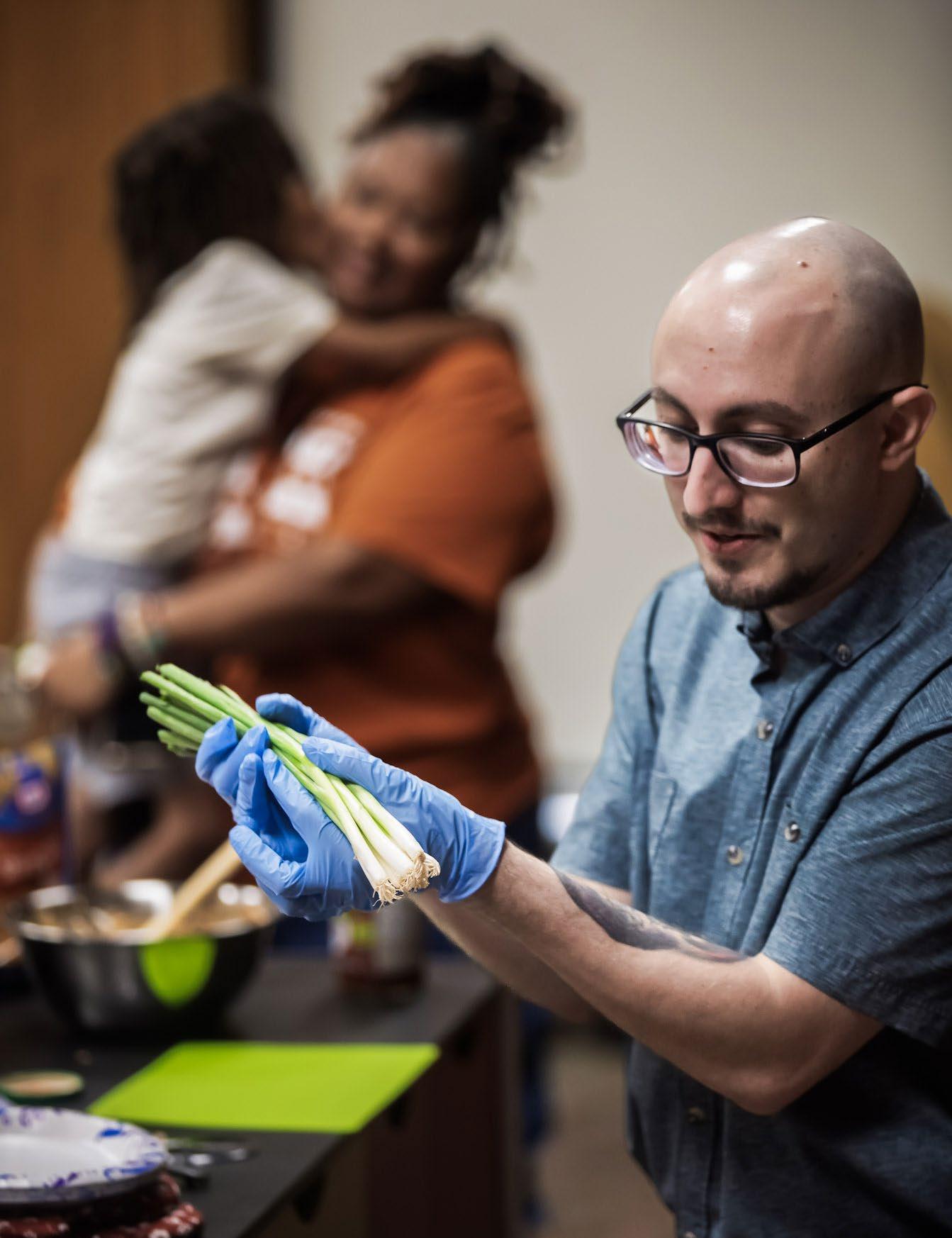
At its heart, Cumberland Cooks isn’t just about food, it’s about neighbors coming together, learning side by side, and leaving with something they can carry home.

When audience member Ja’Nelle Lunnermon was asked why her and her two sons—ages 5 and 10—attended the Sept. 24 demonstration, she stated that cooking was an interest for both of her kids.
The Charlie Carts will be shared throughout all eight libraries in the Cumberland County Public Library system, rotating between two branches every two months.
This month and next, and in July and August next year, the Charlie Carts will rotate between East Regional and Hope Mills libraries. In January, February, September and October next year, the carts will be at Bordeaux and Spring Lake libraries, and in March, April, November, and December next year, the rotation will be between West Regional and North Regional libraries. The Charlie Carts will return to Headquarters and Cliffdale libraries in May and June 2026 in honor of Headquarters Library’s 40th anniversary.
Rotating the carts between the branches allows Cumberland Cooks to reach as many residents as possible. Many residents, including Helga Newman, rely on events being held close to their homes.
“I would attend another,” Newman said, “but not in Hope Mills or East Regional because I can’t get there.”
Of course, no program like this succeeds without engaging presenters. Tonya Minor, one of the Cumberland Cooks' presenters and adult services librarian I, has a clear passion for cooking. When she heard about Cumberland Cooks, she was excited to be a part of the program.
“I like presenting programs and teaching people how to do things,” Minor said, “and I love to cook. We do have other food programs at the library but it’s more extensive with the Charlie Cart.”
The format of each session will depend on the dish, resources available and ages of the participants. Each event will either be a hands-on cooking session, where an
instructor will walk attendees through each step of the cooking process as they make the dish themselves, or a visual demonstration where attendees learn by observing the instructor make the dish.
The inaugural event on Sept. 24 was a cooking demonstration presented by Patrick Parker, adult services librarian II. The audience learned to make two dips, the first being a warm Velveeta cheese dip with ground sausage, and the second being a cold taco-flavored cream cheese dip.
The Cumberland Cooks staff wants to assure all participants feel comfortable and safe when attending a session. If an attendee feels uncomfortable with a certain portion of the process, such as using a knife, they are encouraged to speak up so the presenter can assist. However, each step will be thoroughly explained and demonstrated in order to effectively teach participants the lifelong skills needed to make the cooking process easy and fun.
There are a variety of recipes planned to be taught throughout the course of the program. Some of which include crepes, cheese dip, mocktails, afterschool snacks, herb butters, baby food, and even dog treats.
At its heart, Cumberland Cooks isn’t just about food, it’s about neighbors coming together, learning side by side, and leaving with something they can carry home.
When audience member Ja’Nelle Lunnermon was asked why her and her two sons—ages 5 and 10—attended the Sept. 24 demonstration, she stated that cooking was an interest for both of her kids.
“We homeschool, so it seemed like a cool activity to come and be a part of,” Lunnermon said after the demonstration. “They’re really interested in cooking, and they are in the kitchen with me a lot, so I thought this would be a fun experience with them.” She shared that they all loved the event and that they would absolutely attend again.
Whether attendees are interested in learning cooking skills, discovering new recipes, obtaining resources for food access and budgeting, or making connections with other community members, there is room for everyone at the Cumberland Cooks table.
Sarah Munsch is a freelance writer for CityView She was born and raised in southeast Texas and moved to Cumberland County in November 2024. She attended Sam Houston State University in Huntsville, Texas, where she earned a bachelor’s degree in Mass Communications: Public Relations and Advertising.
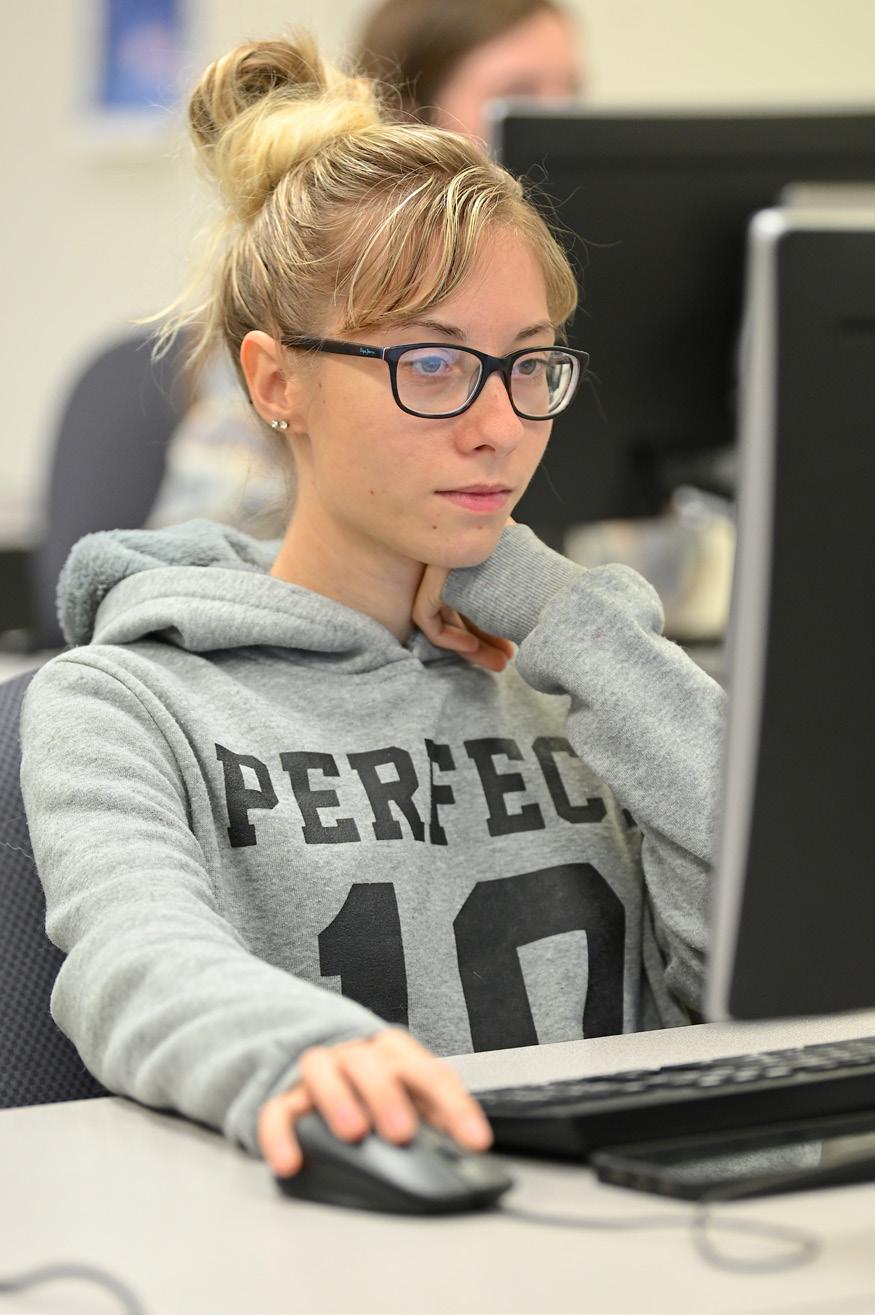



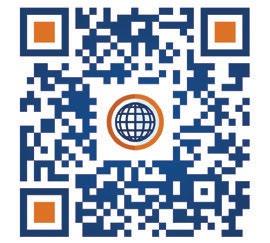


BY CLAUDIA ZAMORA
There is a day on the calendar when the world seems to pause. When silence fills with flowers, sweet bread, old photos, and names whispered with love. That day is Día de Muertos—or Day of the Dead.
For those of us who grew up in Latino homes, this tradition isn’t just something we “celebrate.” It’s something we feel. It’s a ritual that doesn’t try to forget, but to remember differently. It doesn’t fear death. It speaks to it.
Día de Muertos is a Mexican holiday that honors deceased loved ones. It’s said that during these days, the veil between worlds lifts and the spirits of the dead find their way back home. Families create altars filled with marigolds to guide their path, along with photos, favorite foods, drinks, and little pieces of memory that still carry their warmth.
Building an altar is an act of radical love. It’s saying to those we’ve lost: “You’re not alone.”
It’s reminding ourselves that even what leaves us still lingers. That a person lives on in their laughter, in their favorite dish, in a scent that surprises us out of nowhere.
In this country, where death is often met with silence or avoidance, Día de Muertos offers a different kind of wisdom: That to honor is not to cling, it is to give thanks. That to cry is not weakness. It is connection. That naming our dead brings them back into the room of our lives.
Every altar is an invisible conversation. A quiet reunion. A bridge between worlds.
I’ve seen altars in trailers, in classrooms, in tiny kitchens.
I’ve seen children ask about grandparents they never met. I’ve seen elders light candles with closed eyes, as if praying without words.
And in each of those moments, I’ve felt something settle gently in the soul.
Because this tradition is not empty nostalgia. It is cultural resistance. It is a deep root. It is the affirmation that even in death, we are not alone.
There are ways to celebrate this holiday in Fayetteville. Vagabond Cafe and Wood & Grain Designs are hosting an event from 5–8:30 p.m. On Nov. 1 at 108 Hay St. Vagabond Cafe will serve food and Mexican drinks made only for this night, while Wood & Grain Designs invites guests to create their own mini ofrenda: a soulful evening of flavor, music, and living tradition.
This Nov. 1 and 2, let’s set the table for those we’ve loved. Let’s offer their favorite meal, their flowers, their song. And above all, their name.
Because what is named is remembered. And what is remembered lives.

Claudia Zamora is an Argentinian author, mental health and wellness coach, and passionate community advocate. Since 2011, she has made Fayetteville, North Carolina, her home, uplifting the Hispanic community.


PARTNER WITH US THIS GIVING TUESDAY!
Your gifts and donations help support our mission to provide care for those who need it most We hope you’ll partner with us to make a difference in the life of a child.

We provide a home for children up to 21 years old needing out-ofhome placement and make every effort to improve the overall wellbeing of the populations we serve.
The care of children is our foremost concern and the centerpiece of all that we do We have a home serving teen mothers and their babies, a foster care program, an on-campus school for residents of FCH and the community, a second home in Turbeville, SC, and a home for victims of child sex trafficking and exploitation called Magnolia Hope.
BY DIANE PARFITT




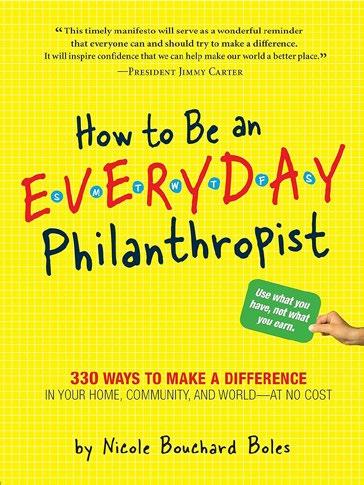


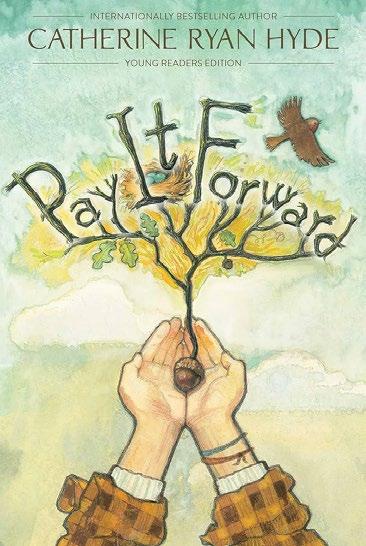
Thanksgiving is often thought of as the beginning of the “season of giving,” when we give to each other and those outside our immediate family in so many ways. Americans traditionally gather at Thanksgiving to share a dinner and special times with family, and reflect and give thanks for the many blessings we have. Many of us want to share these blessings with others by volunteering and donating to charities. Many focus on charitable giving by participating in GivingTuesday, held in Fayetteville through the Cumberland Community Foundation between Thanksgiving and Christmas.
One of the ways we can prepare for this season of giving is to learn about the many other ways we can give. Yes, we can write a check and feel we have done our part, but we can also give ourselves through volunteer work, which can be even more rewarding and may have a greater impact. We can join a group of community volunteers or perform acts of kindness for neighbors or people in nursing homes. We can teach our children the importance of helping each other, our family, our neighbors, and our community, by these acts of giving.
I found some wonderful books that can show us the many ways we can give and do for others.
1. Why Good Things Happen to Good People: How to Live a Longer, Healthier, Happier Life by the Simple Act of Giving by Stephen Post and Jill Neimark
Guided by 50 years of research, Dr. Stephen Post shows us that the acts of caring, kindness, and compassion can in fact have life-enhancing benefits. He and co-author Jill Neimark share moving stories of how love and giving provide us with health, happiness, and a longer life. People suffering from chronic illnesses, including HIV, multiple sclerosis, and heart problems have experienced great health benefits by helping others. The book offers 10 ways to give of yourself in four areas of life that have been proven scientifically to improve your health—and none require writing a check!
2. How to Be an Everyday Philanthropist: 330 Ways to Make a Difference in Your Home, Community, and World—at No Cost! by Nicole Bouchard Boles
Each of us has more to give than we realize. We all want to help make our community, our town, our world a better place but often don’t know how to get started. Nicole Bouchard Boles’ book is a guide to do just that. She helps you inventory your own talents and skills and gives us examples of ways we can use our “personal resource bank” to help others. For example, she tells of a woman who shared her old prom dress with a young girl who could not afford one, the family that took in pets for deployed servicemen and women, or the person who had racked up frequent-flyer miles and
Money is not the only commodity that is fun to give. We can give time, we can give our expertise, we can give our love, or simply give a smile. What does that cost? The point is, none of us can ever run out of something worthwhile to give.
—Steve Goodier
servicemen and women; or the person who had racked up frequent-flyer miles and donated them to a sick child who had a dream of traveling. Perhaps these stories of giving will stir you to give in many other ways.
3. The Giving Book: Open the Door to a Lifetime of Giving by Ellen Sabin
What better way to help children learn about giving than to give them their own book? This book will inspire, teach, and engage them to give back to the world through its unique, interactive process. They will learn the joys of volunteering in their community and in the process they will record their own ideas and write their own stories, which will result in a “scrapbook” of their “giving journey.”
4. One Hen: How One Small Loan Made a Big Difference (CitizenKid, 5) by Katie
Smith Milway (Author), Eugenie Fernandes (Illustrator)
This story is part of CitizenKid, a collection of stories for children to help them become better citizens in our world. In this story, which is based on true events, a boy from Ghana turns a small loan into a thriving business for his family and his community. Kojo must quit school to work with his mother to earn money after his father dies. When his mother receives a small loan from some of the village families, she is able to give Kojo some of it. He uses it to buy a hen, and after a year, Kojo has a flock of 25! He can return to school and eventually his farm grows to be the largest in the region. Children who read this story will learn how a little help can make a big difference.
5. Giving: How Each of Us Can Change the World by Bill Clinton
Former President Bill Clinton’s book is a call to action. He shares efforts by large companies and organizations, and individuals who work to solve problems both here and abroad. The stories in this book show how the giving of time, skills, things and ideas can be as important as the money donated. We all know about the generous giving by Bill and Melinda Gates, but we also learn how a 6-year-old girl in California organized and supervised a drive to clean up the beach in her community.
“We all have the capacity to do great things,” Clinton says. “My hope is that the people and stories in this book will lift spirits, touch hearts, and demonstrate that citizen activism and service can be a powerful agent of change in the world.”
6. Giving Done Right: Effective Philanthropy and Making Every Dollar Count by Phil Buchanan
Most Americans give to charity in some way—through their church, to schools both in their community or their alma mater, or to any number of charitable organizations. No matter how much you are able to give, you may ask yourself the question: “How do I channel my giving effectively to make the greatest difference?” Phil Buchanan is the president of the Center for Effective Philanthropy, and his book will share secrets from some of the biggest givers on how to “make a difference.”
7. Theo of Golden by Allen Levi
All the above books are nonfiction. Here is a debut novel by Allen Levi that tells the story of the mysterious actions of Theo, a Portuguese retiree who arrives in the southern city of Golden. When Theo discovers 92 pencil portraits of various people in a local coffee shop, he decides to purchase them one by one and return them to their “rightful owners.” Through his generosity he makes numerous connections in the community, and we learn more about the kindness of giving. All this is accomplished before his true identity is revealed.
8. Pay It Forward by Catherine Ryan Hyde
Twelve-year-old Trevor McKinney does not have an easy life. His single mom Arlene works two jobs to make ends meet while drinking too much. Trevor has a paper route to help out. But he really likes school so when his social studies teacher assigns the class an extra-credit assignment to plan a project to change the world, Trevor is inspired. While the other students don’t give it much thought, Trevor decides to develop a plan to start a “goodwill chain.” He will help three people and tell them they don’t need to pay him back; they just need to “pay it forward.” His efforts slowly begin to take hold, and unbeknownst to him, a reporter is inspired and begins to write his story and the far-reaching impact of his “goodwill chain.”
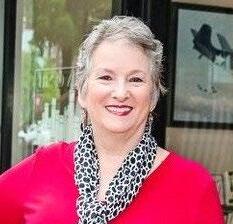
Diane Parfitt owns City Center Gallery & Books in downtown Fayetteville. She can be reached at citycentergallerybooks@gmail.com.

NOVEMBER 2025
Here are just some of the things happening in and around Fayetteville this month. Scan the code with your phone for more events, additional information, and to post your event on our website. Events are subject to change. Check before attending.
Nov. 11
FTCC Women’s Basketball vs. Bryant & Stratton
Reid Ross Classical School
3200 Ramsey St. faytechcc.edu
Nov. 13
Harmony Haven: Pressed Leaf
Art Workshop
Cape Fear Botanical Garden 536 N. Eastern Blvd. capefearbg.org
Nov. 14
Kat Williams: Heaven on Earth Tour
Crown Coliseum
Crown Complex 1960 Coliseum Drive crowncomplexnc.com
Nov. 15
Twinkle Time: Lantern Making Workshop
Cape Fear Botanical Garden 536 N. Eastern Blvd. capefearbg.org
Nov. 17, 21–23
Friends of the Library Book Sale
Headquarters Library 300 Maiden Lane cumberlandcountylibraryfriends.com
Nov. 7
Macon Mayhem vs. Fayetteville
Marksmen
Crown Coliseum
Crown Complex
1960 Coliseum Drive marksmenhockey.com
Nov. 7
Kids Night Out: Moon Walk
Cape Fear Botanical Garden 536 N. Eastern Blvd. capefearbg.org
Nov. 8
MU Football vs. Brevard
Monarch Stadium
Methodist University 5400 Ramsey St. Methodist.edu
Nov. 8
FSU Football vs. Winston-Salem State
Luther Nick Jeralds Football Stadium Fayetteville State University 1401 Murchison Road fsubroncos.com
Nov. 8
Macon Mayhem vs. Fayetteville Marksmen
Crown Coliseum
Crown Complex 1960 Coliseum Drive marksmenhockey.com
Nov. 11
Lego Stem Camp
Fascinate-U Children’s Museum 116 Green St. fascinate-u.doubleknot.com
Nov. 19
FTCC Men’s Basketball vs. Guilford Tech
Reid Ross Classical School 3200 Ramsey St. faytechcc.edu
Nov. 20
Sip and Paint: Coneflower Board
Cape Fear Botanical Garden
536 N. Eastern Blvd. capefearbg.org
Nov. 21–Dec. 7
A Christmas Story
The Gilbert Theater 116 Green St. gilberttheater.com
Nov. 21
Opening Reception SEAR Artist Residency Showcase
The Arts Center
The Arts Council of Fayetteville/ Cumberland County 301 Hay St. wearethearts.com
Nov. 21–22
AMA Partzilla Regional Arenacross
Crown Coliseum
Crown Complex 1960 Coliseum Drive crowncomplexnc.com
Nov. 22
Coffee Cantata Fayetteville Symphony Orchestra Arts XL
214 Burgess St. fayettevillesymphony.org
Nov. 22
Mannheim Steamroller
Christmas Tour
Crown Theatre
Crown Complex 1960 Coliseum Drive crowncomplexnc.com
Nov. 26
Birmingham Bulls vs. Fayetteville Marksmen
Crown Coliseum
Crown Complex 1960 Coliseum Drive marksmenhockey.com
Nov. 28
A Dickens Holiday
Cool Spring Downtown District Downtown Fayetteville adickensholiday.com
Nov. 29
Roanoke Rail Yard Dawgs vs. Fayetteville Marksmen
Crown Coliseum
Crown Complex
1960 Coliseum Drive marksmenhockey.com


November 24 - December 2

This year we are partnering with the Cumberland Community Foundation (CCF) in #GivingTuesday. A match of up to $500,000 is available for gifts received through Cumberland Community Foundation thanks to many generous community donors! Give to Fayetteville Urban Ministry between November 24 and December 2 and YOUR DONATION WILL BE AMPLIFIED.
Deadline to submit checks is Tuesday, December 2 at 5pm.
WAYS YOU CAN GIVE:
Donate online at fayurbmin.org and click “GivingTuesday” or donate by check.
CHECKS MUST BE PAYABLE to CCF or Cumberland Community Foundation

Please write “GivingTuesday - FUM” in the notes
Checks MUST BE DATED November 24 - December 2

The Council on Older Adults has been supporting the independence and wellbeing of seniors in Cumberland County since 1968. Our home and community-based supportive programs include the following:








Meals on Wheels
Home Improvement Program
In Home Aide Services
Information & Assistance
Caregiver Support Groups & Classes
Dementia-related Education & Awareness
Telephone Reassurance & Senior Companion Volunteers And more!
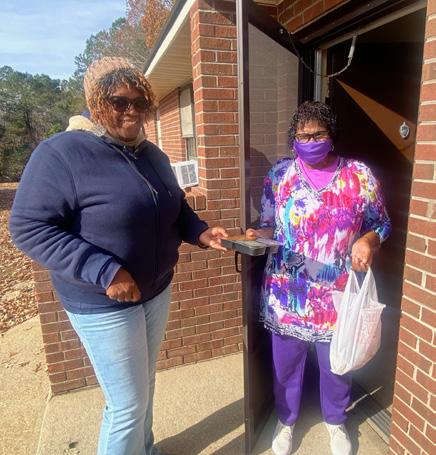
We support hundreds of seniors every day, but nearly just as many are still in need of assistance and we need your help to do more! Please join us this GivingTuesday to make a difference in the life of our senior neighbors right here in Cumberland County!
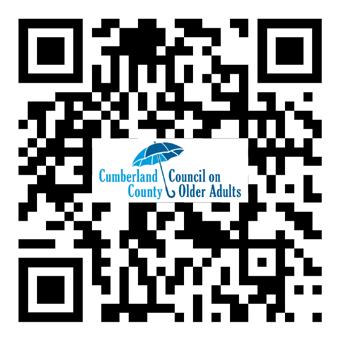





Thank you for supporting CCA and the Campbellton Youth Chorus.





CityView 's 2025 Food, Wine & ART
CityView's 2025 Food, Wine & ART event, presented by Cape Fear Valley Health, was held from 6-9 p.m. Thursday, Oct. 9, at Cape Fear Botanical Garden. Guests enjoyed food and wine while strolling through the gardens and experiencing the magic of theater, dance, music, and art.
Photography by Tony Wooten
Want CityView at your event for Seen @ the Scene? Email us at cmalson@ cityviewnc.com.


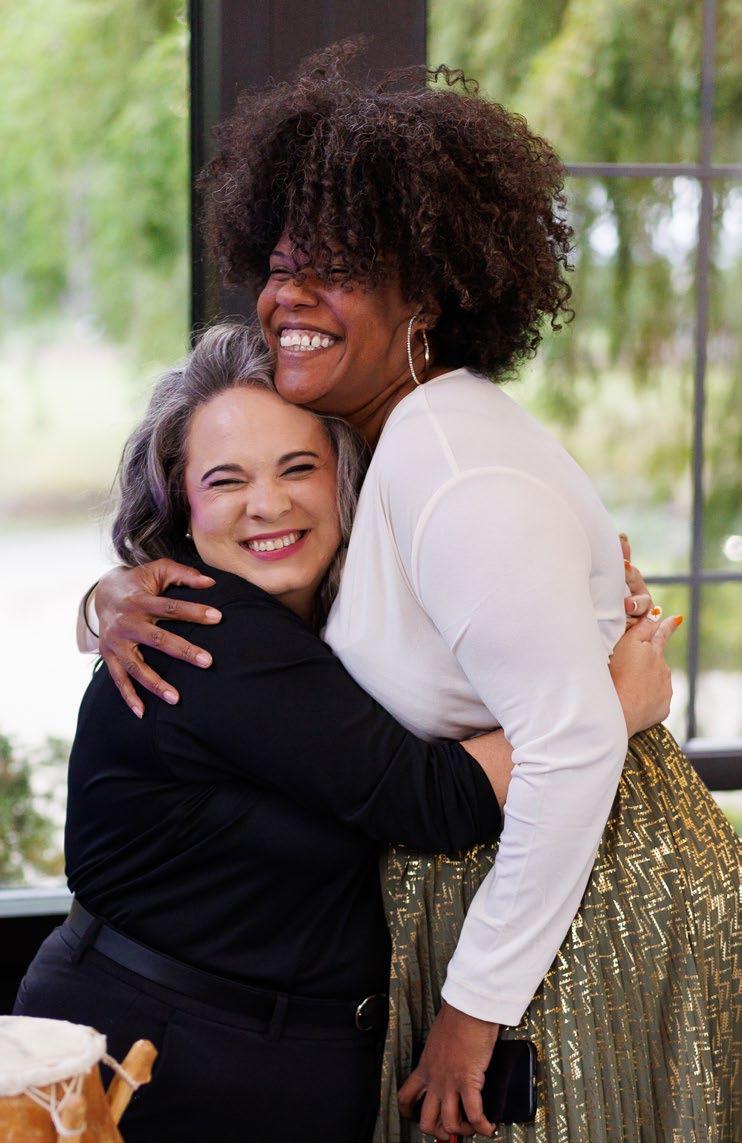

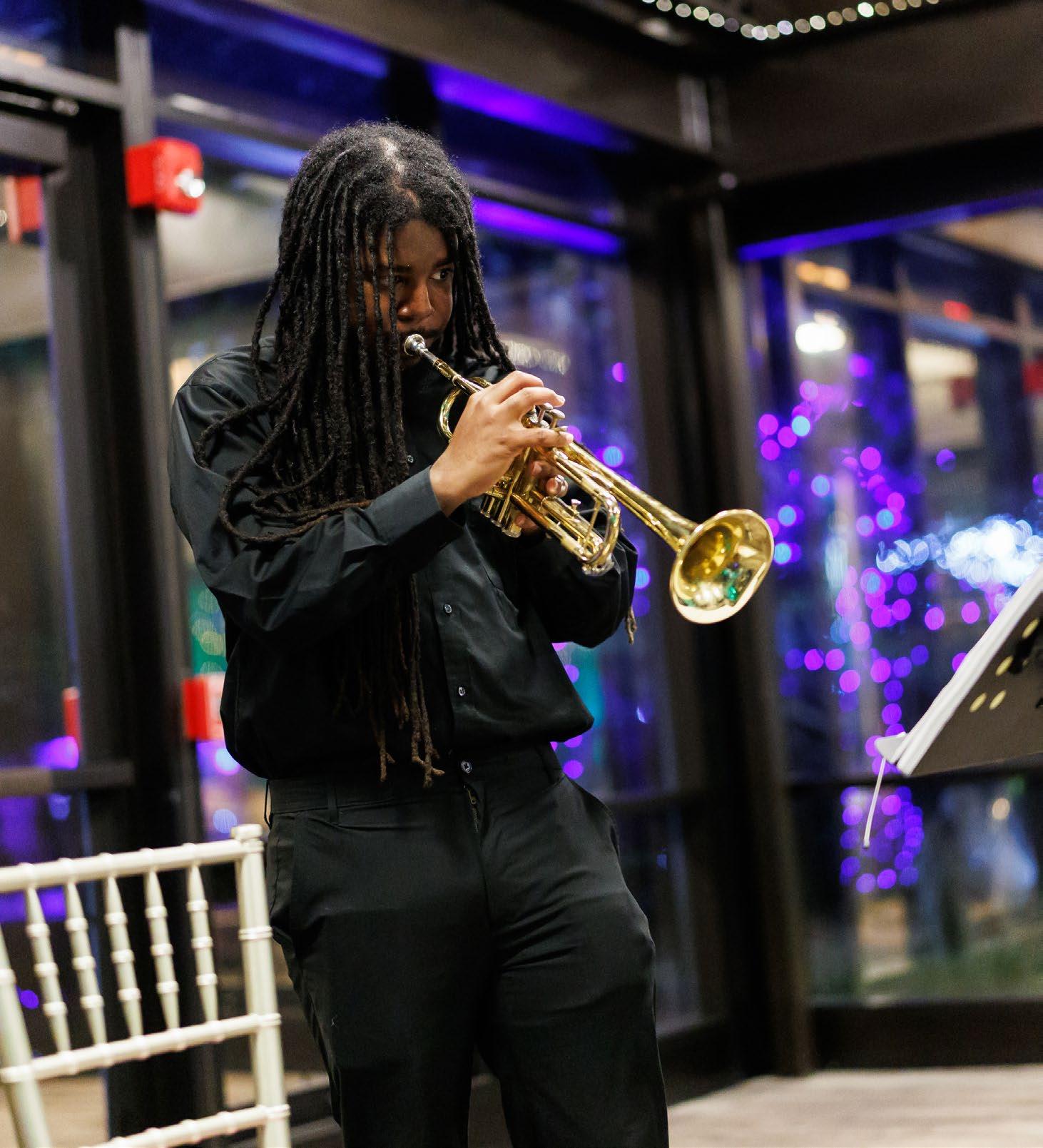






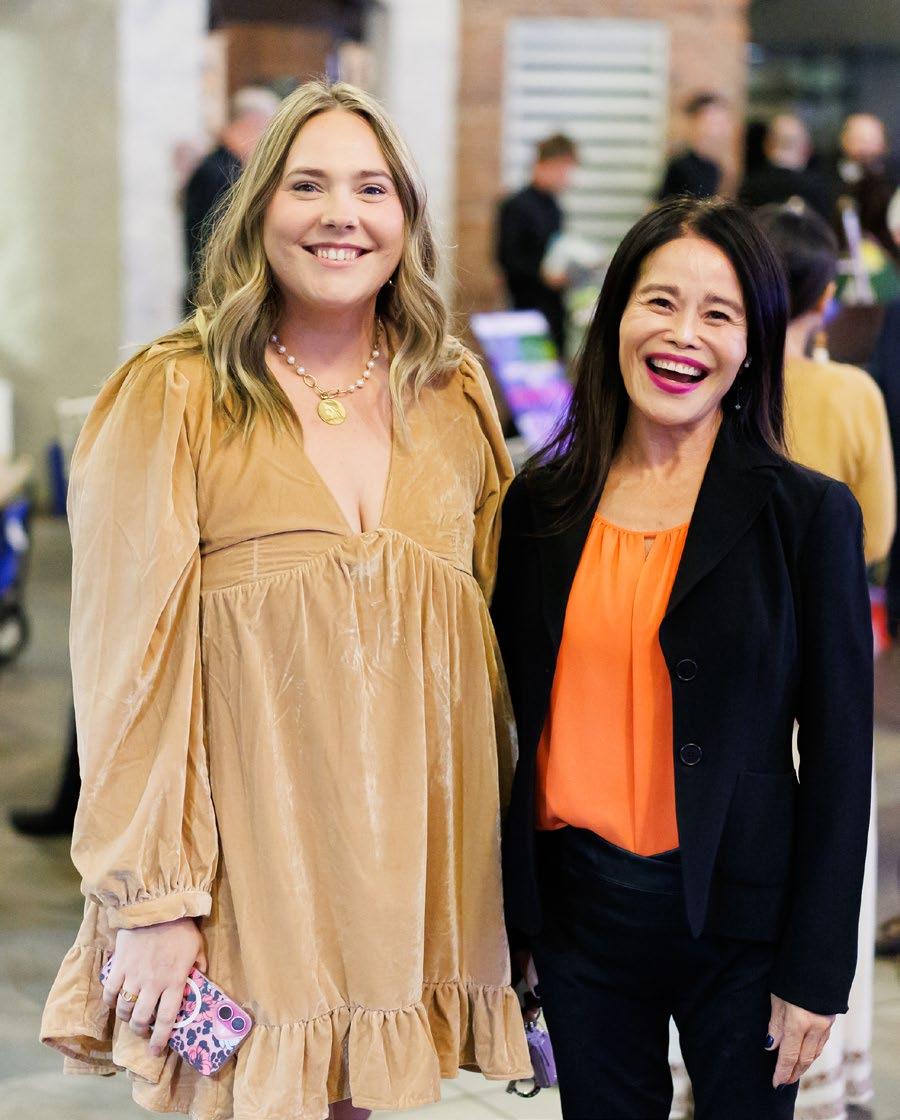

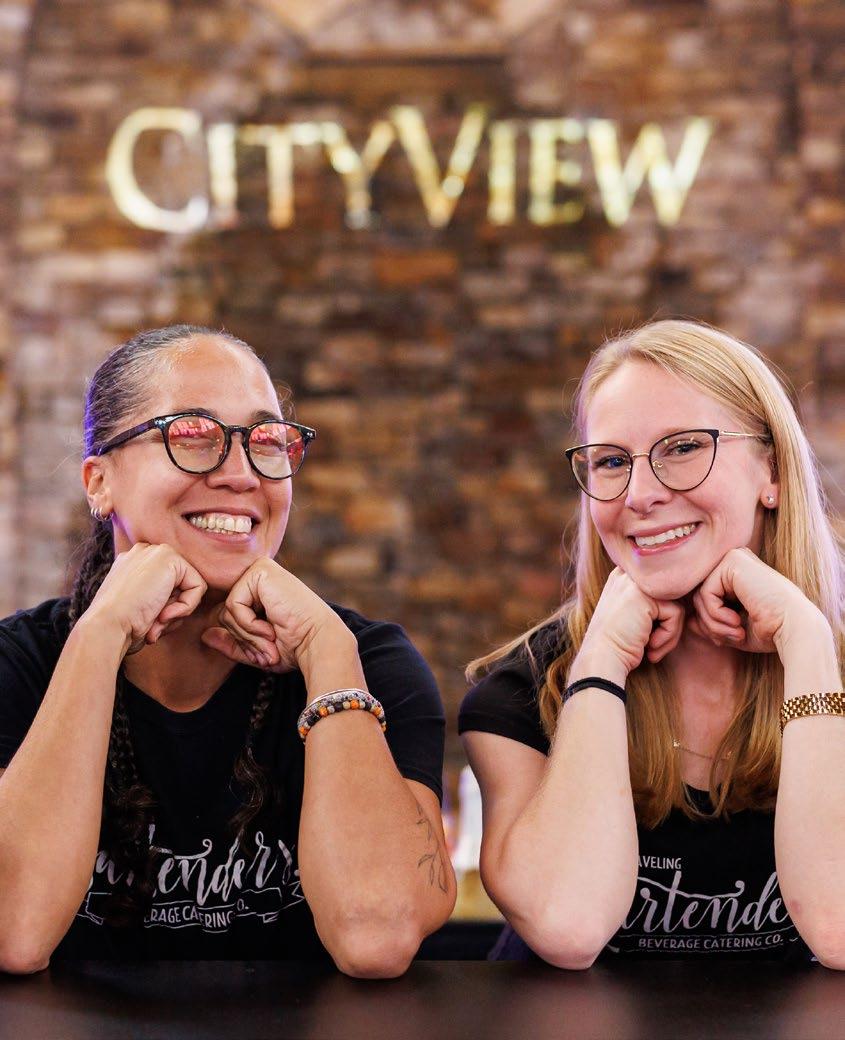

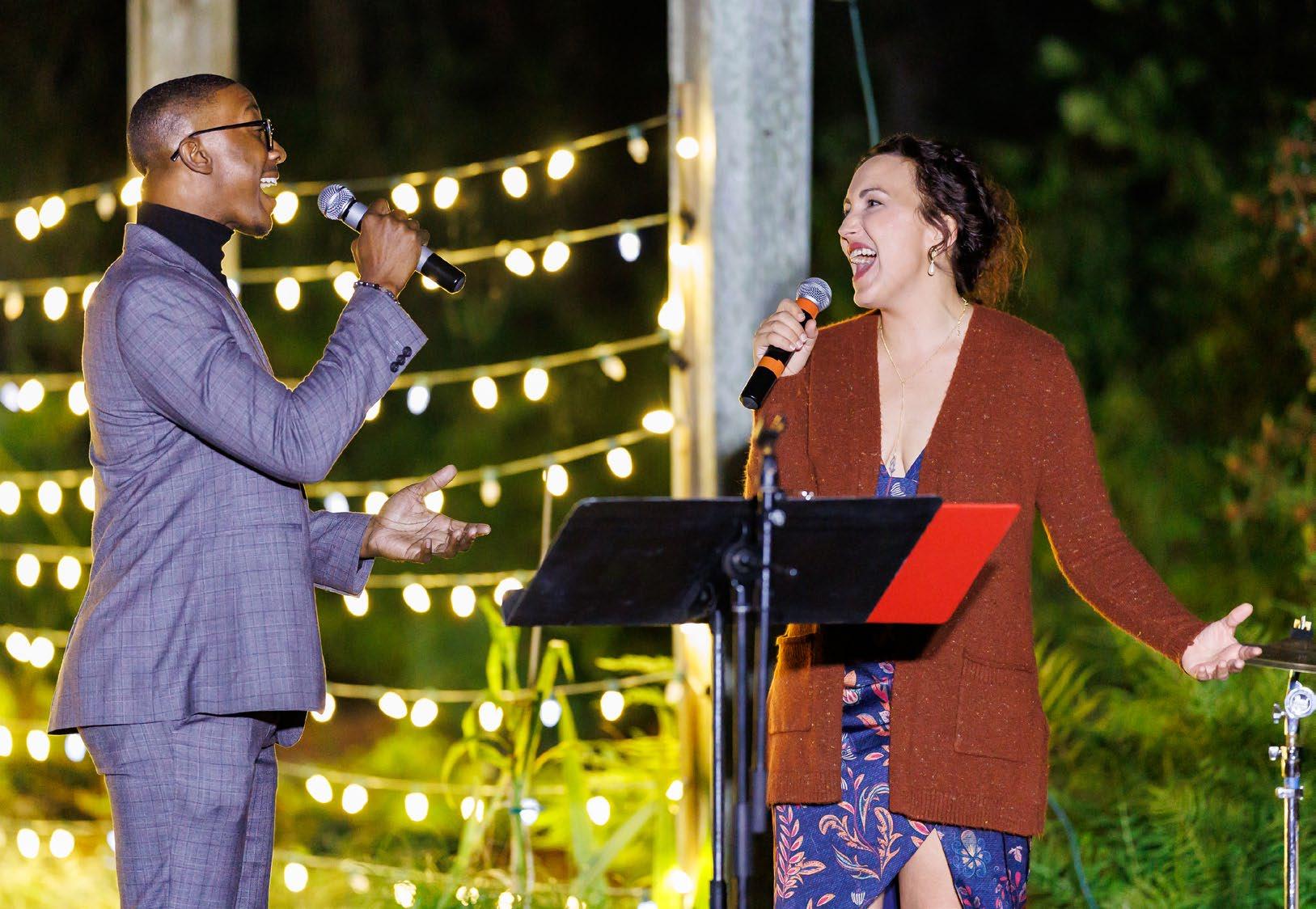

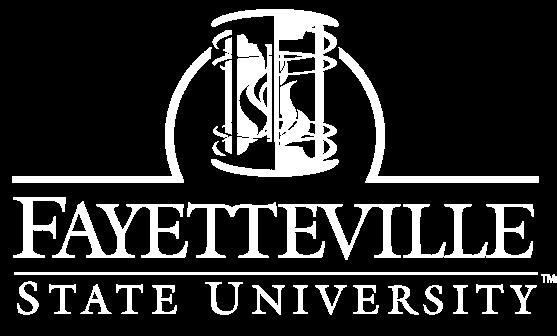




Don’t wait days to see a doctor. We offer same-day care for illnesses, minor injuries, and urgent health concerns— so you can feel better, faster.
• Walk-ins Welcome
• Most Insurance Accepted
• On-Site Lab & X-ray
• Compassionate, Expert Providers
Get the care you need—when you need it.
6201 Raeford Road, Fayetteville | Open every day from 8am – 8pm